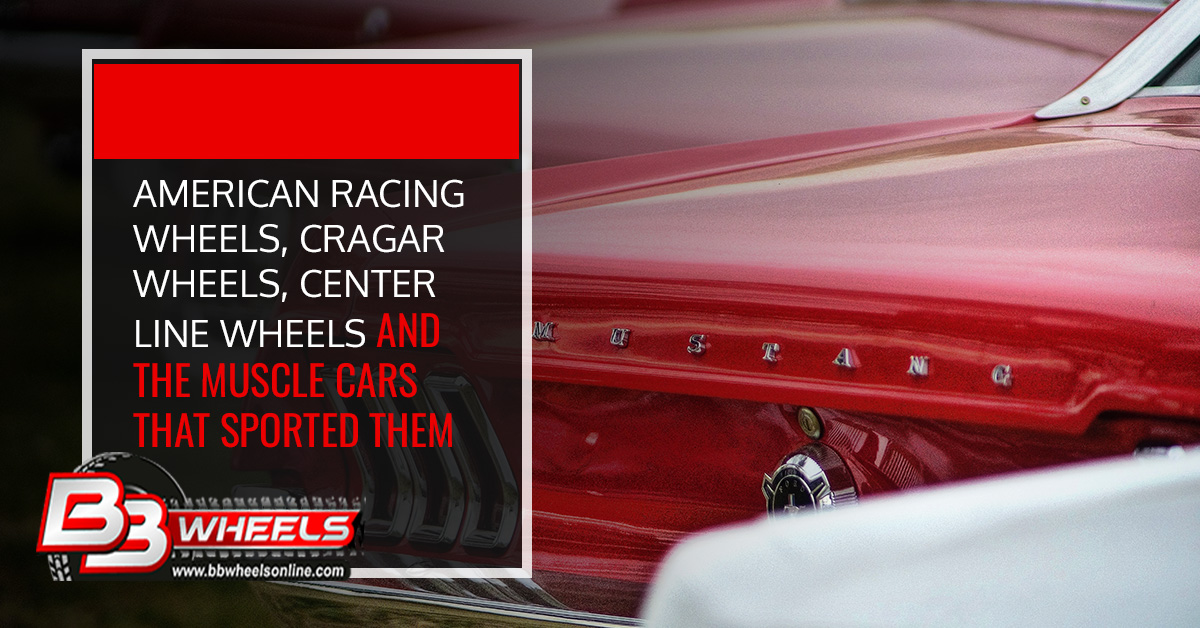American Racing Wheels, Cragar Wheels, Center Line Wheels and the Muscle Cars that Sported Them
22nd Jun 2018

Perhaps one of the most exciting periods in automotive history was during the production years of the classic muscle car. Cars like the Chevelle, Torino and Challenger were big, loud and able to burn through some serious rubber at a standstill.
Beginning in the 60s and through the mid-70s, American automakers were extremely competitive and each year would come out with a muscle car bigger, faster and badder than the year before.
And it wasn’t only about the size of the motor and horsepower, it was about the aggressive styling and features as well. A muscle car was truly a package deal.
This was also an era that saw the emergence of some iconic wheel makers including American Racing Wheels, Cragar Wheels and Center Line Wheels, which are still thriving today and can be found at BB Wheels.
Americans love speed and muscles cars gave them what they desired. The best muscle cars of the era are up to debate. In some ways, there is just no way to compare a 1969 Chevy Camaro to a 1965 Buick Riviera.
Sure, you probably have a favorite, we all do. But this doesn't mean we have to sit around and argue about which muscle car is best. Let’s all just get along and agree that this era produced some pretty amazing cars.
We are here to offer you this list of some of the amazing muscle cars produced in the 60s and 70s. Enjoy.
1969 Dodge Daytona
The 1969 Dodge Daytona is one of the most revolutionary cars you are going to see from this era. The Daytona was not designed for speeding down the street, it was built to win Nascar races.
To help increase speed, the Daytona was put through a wind tunnel and the aerodynamic modifications included a two-foot-long rear wing, long sloped nose cone and a flush rear window.
The results were quite impressive as the Daytona was the first car in Nascar history to exceed speeds of 200 mph. Unfortunately, Nascar would hand down new rules in the early 1970s that would ban the use of this car.
The production cars came out with the legendary 426 Hemi and 440 big block engines.
1970 Oldsmobile 442
The 442 gets its name from the four-barreled carburetor, four-speed manual transmission and dual exhaust. The 442 was based, in part, on the Cutlass and became the hot muscle car for Oldsmobile. The 1970 442 offered a 455 big block V-8 with a whopping 360 horsepower. It could hit 60 mph in less than six seconds.
1968 Ford Mustang Shelby GT500
Mustang purists often opt for the 1965 and 1966 GT 350s because they were light, simple in style and perfect for driving in the street. But the 1968 Shelby offered more fun under the hood and was a clear choice if you wanted to win drag races.
With a 355 horsepower 428 big block engine, you will do just that, win a lot of races. You could expect the Shelby to power through mid to low 14-second quarter mile races.
1970 Chevy Chevelle LS6
For a long time, GM had a rule that forbid engines over 400 cubic inches to be installed in mid-sized cars. But in 1970, they relaxed this rule and dumped a 454 big block into the LS6.
Conservative estimates put the LS6s horsepower at about 450. But in reality, with the giant Holley 780 carb, many experts say that should be closer to 500 horsepower.
Let’s just cut to the chase and say this was a mighty quick car.
1969 Pontiac GTO Judge
There were those at Pontiac who thought a 350-cubic-inch engine was sufficient for the GTO. But Pontiac boss John DeLorean wouldn't have that. He thought no GTO should have an engine that small. So buyers could either choose the standard Ram Air III engine at 360 horsepower or the Ram Air IV at 370 horsepower.
1969 COPO Camaro
The Central Office Production Order was designed for fleet sales, you could order as many of them as you desired. In a nutshell, these were intended to be cop cars and were made with heavy duty suspensions.
However, if you wanted a fire-breathing monster of a Camaro on your force, you could order the 427 big-block with 425 horsepower. That’s enough torque to run down any bad guy.
1970 Plymouth Roadrunner 426 Hemi
Compared to the 1968 model, the 1970 Roadrunner featured an updated front and rear end including a new grille, hood and front fenders. A non-functional hood scoop was also added.
Sales of Roadrunners dropped drastically as insurance companies began adding surcharges to muscle car policies.
If you have any of these classic muscle cars, we are truly jealous. And please buy your wheels from BB Wheels. And send us a picture of your car.


